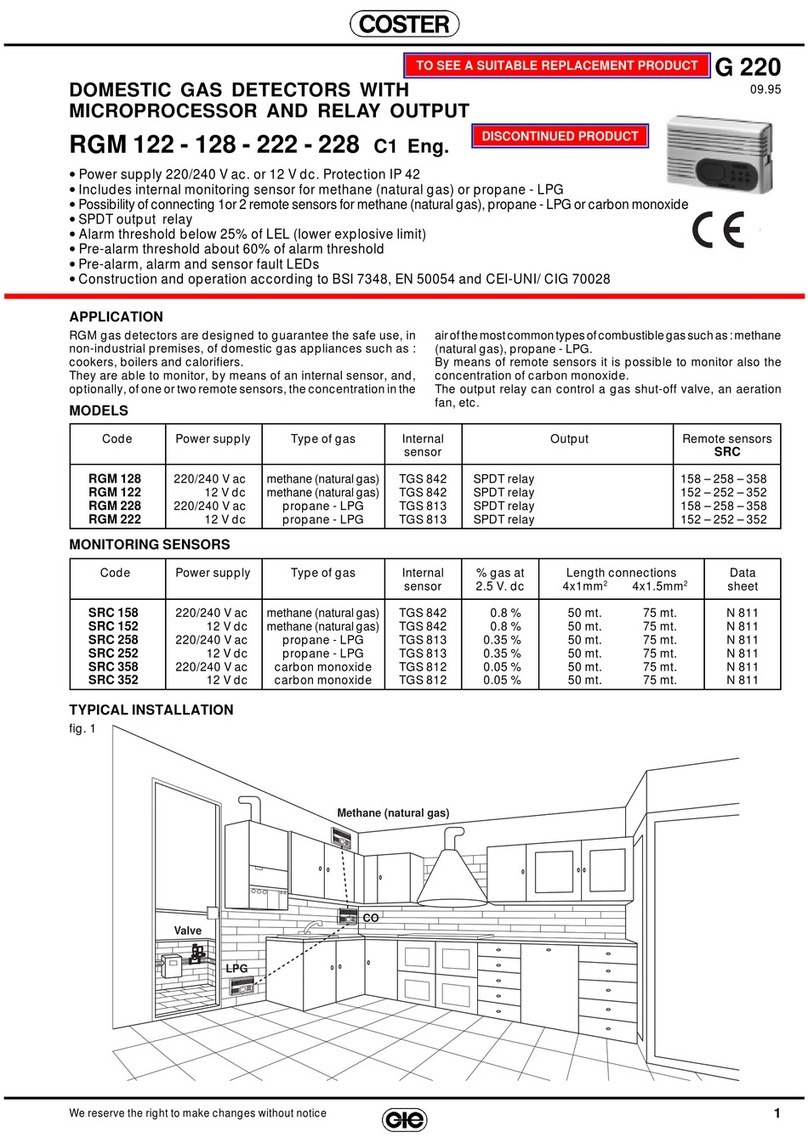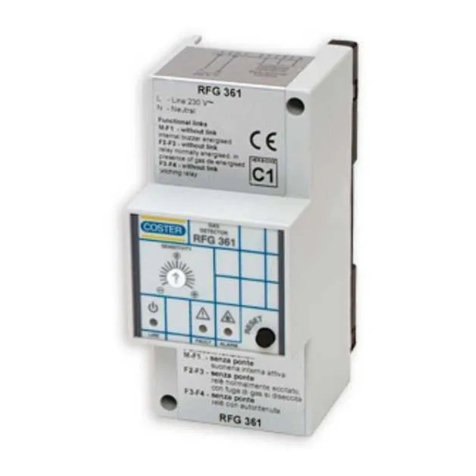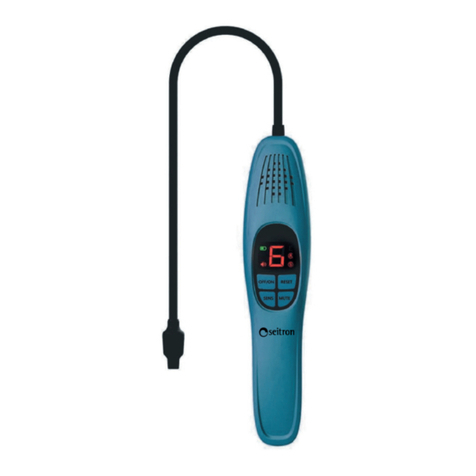
5
G 221 - RGS 128-228 Eng. 25.11.08 MZ REV. 01
We reserve the right to make changes without notice
COSTER
11. OPERATION
11.1 Switching on
As soon as it is powered, the detector does not received alarms, and so does not signal them, for the first two mi-
nutes of operation.
This time is necessary for the gas sensing elements to become stabilised so that their readings can be considered
correct and reliable. During this period the green LED (4.5), which indicates the presence of power, lights intermittently:
at the end of the stabilisation period the green LED remains lit and the detector is ready for gas monitoring.
11.2 Pre-alarm and alarm
The sensing element inside the detector and those in any remote sensors (SRS 158 for methane, SRS 258 for LPG-
propane and SRS 358 for carbon monoxide (CO) monitor the concentration of gas in the air:
– should the reading by any of the sensing elements exceed the pre-alarm threshold, the red LED (4.4) on the
detector starts to flash.
– if the alarm threshold is also exceeded, the red LED lights and stays lit and, with a maximum delay of 30 seconds
(which serves to avoid signalling false alarms due to the temporary presence of gas), the detector switches on the
internal acoustic alarm and closes the output relay.
11.3 Pre-alarm threshold and alarm for combustible gases: methane & LPG-propane
For the combustible gases, methane and LPG-propane, the alarm threshold must not be greater than a concentration
equal to 20% of the LEL (lower explosive limit = volumetric ratio in air of combustible gas or vapour, below which an
explosive mixture is not formed) of the gas to be controlled (regulation UNI CEI EN 50194, point 4.3.3).
For the gases under consideration we have the following values:
Type of gas LEL Maximum threshold Alarm threshold
(20 % del LEL) set by detector
Methane 5% (50,000ppm) 1% (10,000 ppm) 0.80% (8.000 ppm)
LPG-Propane 2.1% (21,000 ppm) 0.42% (4.200 ppm) 0.35% (3.500 ppm)
The threshold for signalling the pre-alarm is established at a value equal to 60% of the alarm threshold.
11.4 Pre-alarm and alarm thresholds for carbon monoxide (CO)
Carbon monoxide (CO) can be controlled by connecting a remote sensor SRC 358 to the detector .
The danger from this gas does not derive from its inflammability or explosiveness, but from its high toxicity. This
danger depends, moreover, not only on the concentration of gas in the air but also on the length of time a person is
exposed to an atmosphere with CO present.
For this reason, it is possible to identify several intervention modes by the detector, that is:
— concentration < 0.005% (50 ppm): the safety of the persons present is assured for an indeterminate time and
so the detector does not intervene,
— concentration 0.005… 0.01% (50…100 ppm): within this concentration range the sensor and the detector for
60 minutes signal a “Pre-alarm” state; then, after this period, go to the
“Alarm” state.
— concentration 0.01…0.03% (100…300 ppm): within this concentration range the sensor and the detector, for
10 minutes, signal a “Pre-alarm” state; then, after this period, go to the
“Alarm” state.,
— concentration > 0.03% (300 ppm): the safety of the persons present is not guaranteed.
The sensor and the detector immediately signal the “Alarm” state.
The concentration values and the times taken into consideration by the sensor and, consequently, by the detector,
are established leaving a large safety margin to ensure the safety of the people present.
The action of the sensor is of the “dynamic” type: if the concentration changes from one range to another, the time
count increases or diminishes as a consequence, thereby modifying the response of the detector. In particular, if
the concentration of CO should fall below 0.005% (50 ppm) for more than one minute, the sensor returns to the
“Normal” condition, cancelling all the times counted up to that moment. As a consequence, the detector will exit
the pre-alarm condition in any event, and from the alarm state if “Without latching” is programmed (see section 8
PROGRAMMER).
11.5 Sensor fault alarm
The detector can signal the possibility that any one of the sensors, internal or external, is defective.
– if the internal sensor has a fault, on the detector facia the yellow LED flashes.
– if one of the remote sensors has a fault, both the yellow LED on the detector and the yellow LED on the defective
sensor flash.
Warning: if the warning “Sensor fault” should light, ask for technical assistance.



























